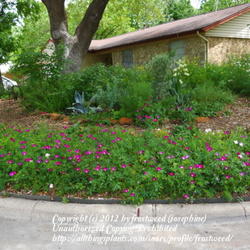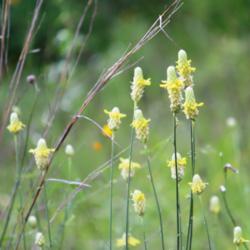


Even if we can’t do a major restoration or landscaping project, a few choice native plants in pots can become a mini-habitat of sorts and a step in the right direction. A successful nectar-rich container combination for bees and butterflies could include plants such as lavender, salvia, achillea, polemonium, and lupin, among others.
Pollinators are absolutely essential to the environment, and bees are the most abundant of the pollinators. The various bee species have different requirements and therefore need a variety of plants in order to meet all of those requirements. For example, bumblebees have long tongues that can reach deep into flowers, while small sweat bees have short tongues and prefer composite flowers of the Asteraceae family, such as chicory, lettuce, dandelion, coreopsis, sunflowers, goldenrod, fleabane, aster, groundsel, eupatorium, ageratum, thistle, ironweed, cosmos, and Black-eyed Susan. The Xerces Society, a non-profit conservation organization, has research showing that native plants are four times more attractive to our native bees than exotic plants are.
Like other pollinators, butterflies and moths depend on specific native plants for their food sources as well as to serve as larval host plants for the next generation. Monarchs, for example, use only the plants of the Milkweed genus as larval hosts. Without those plants, the numbers of their species will continue to decline.




In turn, bees, butterflies, and moths become food sources for many birds. Songbird populations in this country are reported to have been cut over the past 50 years primarily due to the loss of native habitat and the native plants they depend on. A few native wildflowers or shrubs added to a garden will directly help support the bees, butterflies and moths. And, indirectly, they will help support songbird populations as well.
Native plants and wildfowers are adapted to local soil and climate conditions, which often makes them easier to grow than exotics. If placed in the right locations, they do not need extensive -- and often expensive -- fertilization or care. Many can exist under the toughest conditions.



Some additional benefits of native plants and wildflowers: They can be educational (such as studies of their names, history, and folklore), they provide year-round interest with a minimum of maintenance, they can often provide winter interest in areas where exotics cannot survive year round without being moved indoors or to a sheltered winter location. Because native plants are adapted to their locations and need little care, they can help reduce the use of inorganic and polluting fertilizers, herbicides, pesticides, and fungicides. They can provide natural windbreaks and erosion control. Natives and wildflowers can also be used to re-establish natural populations of wildlife and the ecosystems needed in order for them to survive and thrive. Additionally, they often provide food for humans, and many have medicinal benefits as well. The enjoyment and economy of collecting the seeds help assure that large areas of land may be planted with wildflowers even on a limited budget.
The need for more natives and wildflowers has never been greater. The benefits of growing them are quite remarkable. We do have the power to make a difference in our environment.




(Top photos: from Oregon State Archives - in the public domain, top (r) Carrizo Plain wildflower meadow in moonlight by Bill Bouton (cc-by-sa 2.0); second group of photos are from the ATP Wildflowers forum - by purpleinopp, gardengus, and Horntoad; third group (R) by growitall in the ATP Rock Gardens forum)
| Thread Title | Last Reply | Replies |
|---|---|---|
| Thank you for another wonderful Article. by frostweed | Oct 26, 2014 5:33 AM | 12 |
| Love this article by lorishell | Oct 26, 2014 5:28 AM | 1 |
| Small efforts matter by CarolineScott | Oct 22, 2014 4:09 PM | 3 |